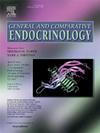Amino acid residues critical to cAMP signaling by V2a-type vasopressin/vasotocin receptor: an evolutionary perspective
IF 1.7
3区 医学
Q3 ENDOCRINOLOGY & METABOLISM
引用次数: 0
Abstract
Vasopressin (VP) and its non-mammalian homolog vasotocin (VT) are secreted from the posterior pituitary to control various physiological phenomena via G protein-coupled receptors. The six known subtypes of VP/VT receptor family (V1a/bR and V2a/b/c/dR) originate from a single ancestral molecule, that most likely coupled with Gαq and used Ca2+ for signaling. However, among the current VP/VT receptors, V2aR predominantly couples with Gαs and increases intracellular cAMP levels. This receptor is also known to mediate the potent antidiuretic effect of VP/VT, and therefore is clinically important. Although the structure-function relationship of V2R has been of great interest to researchers, an evolutionary perspective was missing; how did the ancestral V2aR switched its G protein selectivity? To address this question, a comparative study between V2aR and its Ca2+-signaling cognates (V2b/c/dR) is needed. The aim of the present study was to identify residues/motifs that are crucial to cAMP signaling by V2aR; chimeric receptors were engineered using the functional V2aR and V2bR of medaka. In vitro assays demonstrated that Gαs-coupling ability of the receptors can be altered by swapping a single residue in the second intracellular loop (ICL2), without affecting Gαq-coupling ability. The three-dimensional models predicted in silico suggested that the interaction between ICL2 and Gαs-αN chain and Gαs-β2/β3 loop contributes to the stabilization of the signaling complex, enhancing the receptor’s capacity to stimulate cAMP pathway upon ligand binding. These findings provide new insights into the molecular and functional evolution of V2aR, as well as into the mechanisms of G protein selectivity of GPCR.
v2a型后叶加压素/后叶催产素受体对cAMP信号传导至关重要的氨基酸残基:一个进化的视角
垂体后叶加压素(VP)及其非哺乳动物同源物血管催产素(VT)通过G蛋白偶联受体从垂体后叶分泌,控制各种生理现象。已知的6种VP/VT受体家族亚型(V1a/bR和V2a/b/c/dR)起源于一个单一的祖先分子,最有可能与Gαq偶联并利用Ca2+进行信号传导。然而,在目前的VP/VT受体中,V2aR主要与g - αs偶联并增加细胞内cAMP水平。该受体还介导VP/VT的有效抗利尿作用,因此在临床上具有重要意义。虽然V2R的结构-功能关系一直是研究人员非常感兴趣的,但缺少一个进化的视角;祖先V2aR是如何改变其G蛋白选择性的?为了解决这个问题,需要对V2aR及其Ca2+信号同源物(V2b/c/dR)进行比较研究。本研究的目的是鉴定V2aR对cAMP信号传导至关重要的残基/基序;利用medaka的功能V2aR和V2bR构建嵌合受体。体外实验表明,通过交换第二胞内环(ICL2)中的单个残基,可以改变受体的g αs偶联能力,而不影响g αq偶联能力。三维模型预测表明,ICL2与g -α s-αN链和g -α s-β2/β3环的相互作用有助于信号复合物的稳定,增强受体在配体结合时刺激cAMP通路的能力。这些发现为研究V2aR的分子和功能进化,以及GPCR对G蛋白的选择性机制提供了新的见解。
本文章由计算机程序翻译,如有差异,请以英文原文为准。
求助全文
约1分钟内获得全文
求助全文
来源期刊

General and comparative endocrinology
医学-内分泌学与代谢
CiteScore
5.60
自引率
7.40%
发文量
120
审稿时长
2 months
期刊介绍:
General and Comparative Endocrinology publishes articles concerned with the many complexities of vertebrate and invertebrate endocrine systems at the sub-molecular, molecular, cellular and organismal levels of analysis.
 求助内容:
求助内容: 应助结果提醒方式:
应助结果提醒方式:


